The 10.1-megapixel Olympus E-3 is a high-end professional digital SLR with an exceptionally fast auto-focus system, built-in image stabilization, Live View and excellent image quality. It’s a part of the Four Thirds digital SLR system, which has a smaller sensor and a different lens format from most other cameras.
Want to buy a Olympus E-3?
Compare prices and shop For Olympus E-3 >>
| Olympus E-3 Studio Test Images | ||
| ISO 100 Sample >> ISO 200 Sample >> ISO 400 Sample >> ISO 800 Sample >> ISO 1600 Sample >> ISO 3200 Sample >> |
||
Introduction
Olympus finally delivers the long-awaited E-3: a 10.1-megapixel, Four Thirds System digital single-lens reflex camera body that claims to be “the ultimate choice for the professional photographer … [providing] the highest levels of speed and image quality as well as Live View capabilities and the ultimate in reliability.” Indeed, the Olympus E-3′s pro-oriented features will set you back about $1,699 (retail list price). This camera has been more than four years in the making. Was it worth the wait? In short, yes.
Features
The Olympus E-3 is packed with features well suited to how photographers actually work. The most-used photographic controls are close at hand and quick and easy to adjust — just what you would expect from a professional-level camera. Most of the dedicated button controls are the hold-down-and-turn-dial variety, which work great.
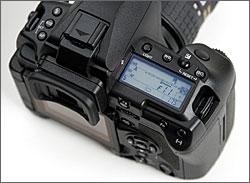 |
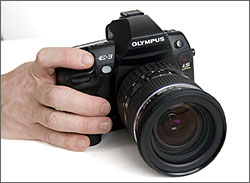 |
|
| Olympus E-3 top controls and front view with the new Zuiko Digital 12-60mm SWD zoom lens | ||
![]()
The E-3′s relatively large viewfinder features a 100 percent field-of-view, a built-in eyepiece cover for Live View shooting and a display that includes the ISO setting.
Olympus boasts the fastest auto focus system to date (as of October 2007) when used with their new Zuiko 12-60mm SWD zoom lens. I did not directly compare it with other systems, but my impression is that it is at least on par with them, if not faster.
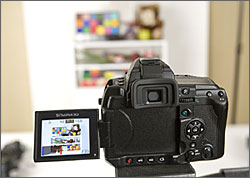
The articulating (vari-angle) 2.5-inch high-resolution LCD monitor is useful for odd angles and for macro work with Live View shooting. I was a bit dubious about the value of Live View modes, but I have come to appreciate the option of shooting in this fashion, particularly with the articulating LCD screen. The drawback in Live View mode, however, is some shutter lag. A work-around is to use the motor drive in high-speed mode and hope that its timing matches your intent.
The control layout’s dedicated buttons for primary photographic controls are located near the shutter-finger and thumb-grip positions making adjustments quick and easy.
Olympus’s Supersonic Wave Filter dust-reduction system was the first of its kind and operates automatically. Because introducing dust and debris into my camera is counterproductive, I’ll leave that to the gadget sites that occasionally break things as part of their “testing.”
The E-3 has two white balance sensors, one as part of the internal metering and another external sensor located in front next to the handgrip. The E-3′s double white balance sensors appear to work well, although there will always be some mixed light or fluorescent light situations that require post-production tweaking. The system exposed indoor light well – particularly tungsten light sources and more recent compact fluorescent lights. When tweaking in RAW format was necessary, I found the adjustments to be minor: often nudging the Kelvin scale plus or minus 200 degrees and adding a slight tint of magenta did the trick.
Battery life is excellent, in my opinion. Using the E-3 with one battery and without the vertical grip over several days, I got well over 400 frames, including “chimp time” (looking at pictures in the LCD) customizing menus and some Live View shooting. I also mainly shot in high speed drive mode.
The E-3 accepts two memory-card formats: Olympus’s xD-Picture Card and standard CompactFlash. Personally, I would prefer to see SD or a second CompactFlash slot instead of the xD. Most of us try to own only the cards we really need, and SD and CF are far more commonplace than xD-Picture Cards. To my knowledge, xD offers no practical speed or capacity advantage. Olympus has an investment in its xD-Picture Card format, and those who already own xD cards will be pleased.
The unique Four Thirds System makes available some interesting lens options. Compared to a full frame digital or 35mm camera, the Four Thirds System offers twice the reach at the same focal length. So a 50mm Four Thirds lens is like a 100mm lens on a 35mm film camera. The following are Olympus’s own Zuiko Digital lenses; all but the last employ Olympus’s latest Supersonic Wave Drive (SWD) technology for fastest auto focus. Note the 35mm/full frame equivalent range in parentheses:
- Olympus Zuiko Digital ED 12-60mm (24-120mm equivalent) f/2.8-4.0 SWD
- Olympus Zuiko Digital ED 14-35mm (28-70mm) f/2.0 SWD (Olympus claims this is the world’s first continuous f/2 zoom.)
- Olympus Zuiko Digital ED 50-200mm (100-400mm) f/2.8-3.5 SWD
- Olympus Zuiko Digital ED 70-300mm (140-600mm) f/1:4.0-5.6 (Unless I were going on safari, I’d opt for an SWD lens instead.)
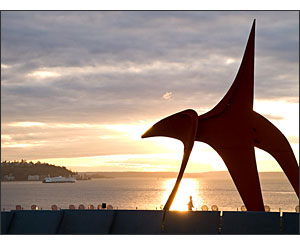 |
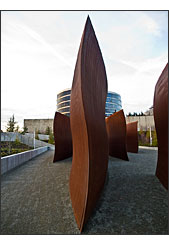 |
Camera Menus
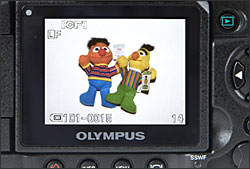 Olympus E-3 basic playback display |
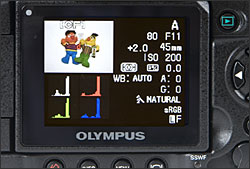 Olympus E-3 playback display info and RGB histogram |
|
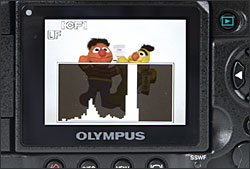 Olympus E-3 playback display with luminance histogram |
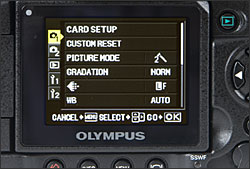 Olympus E-3 main menu |
|
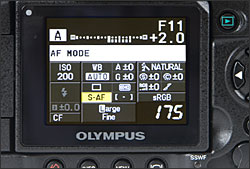 Olympus E-3 main data display |
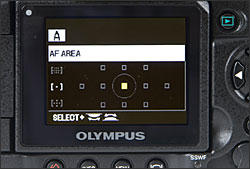 Olympus E-3 auto focus target display |
![]()
Design
With larger, high-end DSLRs, there’s a lot more physical space to locate controls and displays, as well as larger grips. Designers have room to put controls where photographers need them most — close at hand (finger, actually), which generally leads to better usability.
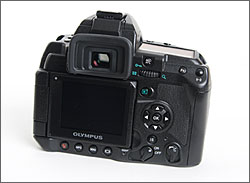 |
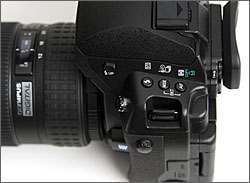 |
|
| Olympus E-3 Controls | ||
![]()
The first thing you notice with the E-3 is how the primary photographic controls are nicely arranged around the body. Things like exposure compensation and ISO get their own buttons right near the shutter button. The rear thumb dial is right under the AE-L/AF-L button for those of us who like to activate auto focus using the rear AE-L/AF-L button. There is also a function (Fn) button just to the right of where your thumb rests. The two thumb-aligned buttons are also customizable and swappable. The less-used but important controls for auto focus mode, drive mode, metering and flash are located on the top left. Menu controls are under the LCD, and the four-way menu navigation keypad is right where you expect to find it. Simple. Efficient.
One of the drawbacks I found with the Olympus E-510 I reviewed earlier was that customization of controls was unnecessarily complicated and confusing. I thought it could be simpler. Olympus has done just that with the E-3. All the options are still there, but now they’re neatly organized and arranged under menus that make intuitive sense. Normally, when I receive a camera for review, I spend some time making sure I understand the control philosophy, navigation and customization options. With the E-3, it was pretty much power up and off you go. There was little immediate need to customize or tweak and much less need for the manual than usual. Thank you, Olympus, for making life easier!
Camera Experience
Compared to entry-level DSLRs, mid-level and pro-level machines tend to be faster and sturdier. They’re more expensive because they’re workhorses that get the job done efficiently, day after day. The Olympus E-3 is an excellent workhorse.
While all the main controls have dedicated buttons, you can still use Olympus’s Super Menu system, where functions displayed on the rear LCD can be selected via the keypad – or changed using the dedicated rear menu controls. This control redundancy is useful as different photographers have different styles and preferences.
As I said, it was pretty much power up and go with the E-3. Other than having to develop muscle memory for the controls, I found working with the E-3 consistently predictable in a variety of situations and environments. Auto focus was fast and sure. Metering was predictable, and exposure responded consistently to changes in subject and lighting. With many cameras, exposure can change subtly from frame to frame even when the lighting and subject composition are constant. The E-3′s exposure is very consistent. Although we can make adjustments in post-processing, consistency has practical significance for studio shooters and others who need results to be predictable within tight ranges.
I especially like the E-3′s new playback zoom. Previously, in playback mode, you could set the zoom to jump immediately to some preset magnification ratio. This was great, but you had to scroll from the center to find the focus point you wanted. The E-3 allows you to be more selective about the zoom point, as well as the zoom amount. In playback, you press the Fn key and the image remains full frame with a 10x zoom point highlighted. If you want to zoom more or less, just turn the control dial, and the highlighted point changes with your selection. Use the arrow keys to move the zoom point, and then press the Fn button again to drill down.
While testing in and around Seattle, the twin white balance sensors did their thing just fine and I was comfortable using auto white balance most of the time. That said, I do like to set a custom white balance if the light source is going to be consistent, and the E-3 provides a fast, direct means of setting a custom white balance. By assigning the rear function button (Fn) to custom white balance, you simply hold it down while exposing a frame of white paper, wall, shirt or whatever. The E-3 automatically measures and switches to the custom balance. Excellent.
Olympus’s new auto focus system is indeed remarkably fast and consistent with the new 12-60mm zoom. It’s a little slower and less reliable with the Zuiko Digital ED 70-300mm (140-600mm equivalent!) because that lens does not use Supersonic Wave Drive. I wasn’t able to shoot any sports, so I went hunting for birds in the bush. On an overcast day, I got usable (if not really notable) photos through the branches. The auto focus system — set to the center AF point — performed well, given the tricky task of distinguishing my intended focus point in between criss-crossing branches. It was also a relief to find that the E-3 doesn’t appear to be plagued by back-focusing issues like some digital SLRs have been.
Of the in-camera image stabilization systems I’ve used, I find Olympus’s to be extremely good and definitely on par with optical IS systems for the 12-60mm zoom range. While testing with the Zuiko Digital ED 70-300mm, I shot a lot of handheld frames zoomed out to 300mm with shutter speeds around 1/100th of a second (See birds below). Surprisingly, many motionless subjects were tack-sharp or very close, while panning shots were a bit hit or miss. It’s impressive just how slow of a shutter speed the Olympus system enables you to use in real-world situations.
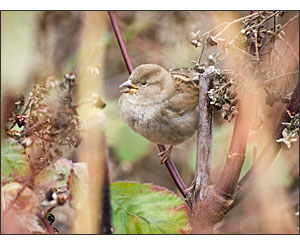 |
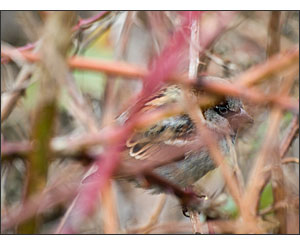 |
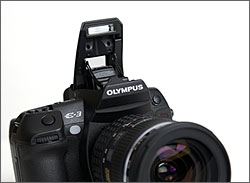
The camera’s other systems all worked well in my testing. Studio flashes fired (as slaves) with the pop-up unit. The strobes synced properly with the exposure; other cameras sometimes fire a pre-flash that triggers slaves before exposure. The shutter-release sound was about average to my ear and its pitch was neither noticeably high nor plasticky-sounding. The vertical grip functioned well, but I wish it had the AE-L/AF-L button as well as the Fn button. If you want rear-activated AF when using the vertical grip, you can work around this by swapping the thumb buttons’ functions in the customization menu.
![]()
Image Quality
Top-notch functionality is great, but we want top-notch image quality too. Combined with the Zuiko Digital ED 12-60mm SWD zoom, I think the E-3′s overall image quality is outstanding.
Bear in mind, however, that I have not done a direct comparison with other recent digital SLR bodies — my opinion is based on past experience and recent work with a Pentax K10D, Canon EOS 5D, and Canon EOS 40D. While the Olympus E-3 might not win the ultimate pixel-peeping quality contest, it is easily worth any serious photographer’s consideration. It will be amazing when digital cameras can operate at ISO 1600 or 3200 the way we use ISO 200 today, but in the meantime, it’s not a reason to limit your camera choices to only those with the absolute cleanest files.
The Olympus E-3 produces RAW files with wide latitude for adjustment without increasing noise levels too much. They respond well to the new sharpening, exposure and white-balance tools in Adobe Photoshop Lightroom. Color balance is very natural and neutral to my eye, and easily adjusted to achieve the look I want. Compared to other cameras, I think my workflow moves fastest with Olympus’s RAW files. Again, white balance problems were often fixed quickly by shifting the tint to magenta and tweaking the overall color temperature.
I’ve been very impressed with image highlights in the latest crop of DSLRs, and the E-3 is no exception. Clouds in the sky and light reflecting off windows look much more realistic than before, particularly when shooting RAW and using Lightroom’s Recovery tool to pull back the highlights a bit. Gradients have a smoother blend, which helps give images a much more realistic appearance.
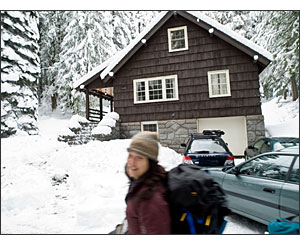 |
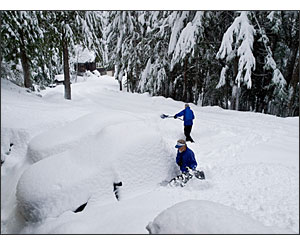 |
Shadows are very clean-free of obtrusive noise patterns-up to ISO 800. When shooting RAW, noise in the shadows cleans up fairly well, even at ISO 3200 — although you will notice the grain. This is the one area where your preferences will really only be satisfied by seeing actual files at 100 percent (see Olympus E-3 studio sample photos). I’m fairly tolerant of noise; others are not. For me, ISO 1000 is the E-3′s crossover point. The good news is that low-light shadow gradients are looking smoother than ever — blotchy grey-yellow shadow areas are becoming a thing of the past.
Sharpening and noise reduction in the E-3′s RAW files are excellent. It doesn’t hurt that the Zuiko Digital ED 12-60mm SWD is extremely sharp throughout the zoom range and even wide open. Capture-sharpening is therefore minimal, and noise is primarily luminance.
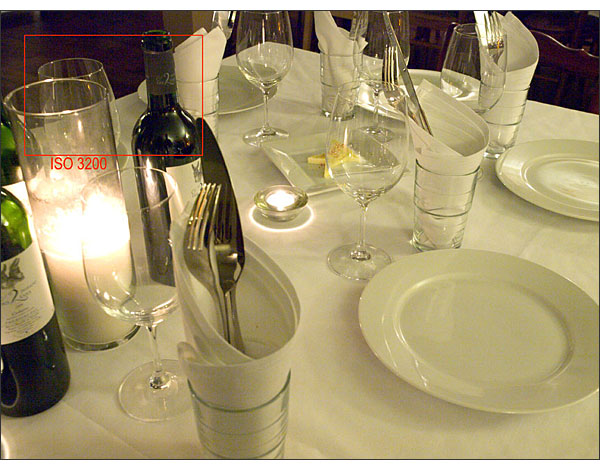
Conclusion
Photographing with the Olympus E-3 is a bit like driving a sports sedan. You may not need the speed and power most of the time, but you’re sure glad it’s there when you do. Plus, you get comfort and style with your scoot. The E-3 is more than competent for everyday shooting, and its speed and burst depth handle demanding moments with ease. Then, when you’re pushing pixels, the E-3′s files help you get back to pushing shutters sooner.
For photographers who aren’t heavily invested in another brand’s system — financially, psychologically or both — the Olympus E-3 offers great value for the money, along with the unique Four Thirds System of lenses and other accessories. Ultimately, however, the question is how well the E-3 stacks up against its nearest competitors: the Nikon D300, Canon EOS 40D and Sony Alpha DSLR-A700. Of these cameras, I’ve only used the 40D, so I won’t hazard a guess about which is better suited for what. But I will say that the E-3 is in a niche by itself when you consider its features and the Four Thirds System lenses. Thus, the direct technical comparison may not be so clear for those who are considering subjective camera attributes in their purchasing decision.
The E-3 has so many good things going for it that it goes beyond being just another “me-too” DSLR system. It’s a serious contender among its competitors and its combined features make the Olympus E-3 a truly distinctive alternative to the mainstream. If the benefits of the Four Thirds System appeal to you, the choice is clear.
Who Should Buy It
The Olympus E-3 will please just about any type of photographer, with the exception, perhaps, of stock photographers who use only maximum megapixel machines. Wildlife photographers, in particular, will benefit from the relatively smaller and lighter long telephoto zooms that the Four Thirds System offers. Sports shooters, too, will find the system useful for all but the most demanding situations where more frames-per-second are necessary. Wedding photographers and others will appreciate the predictable metering. Finally, everyone can take advantage of features like the pivoting LCD with Live View.
- end -
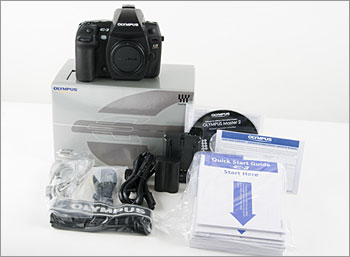
Contents of the Olympus E-3 Box
|
Other Resources:
Shop For Olympus E-3 >>
Olympus E-3 User Reviews >>
Write a Olympus E-3 Review >>
Olympus E-3 Camera Specs >>
Olympus E-3 Sample Gallery >>
Olympus Web site >>
All Digital Camera Pro Reviews >>
Digital Camera Buyer’s Guide >>
All Digital Camera Sample Images >>
LRY Profile >>


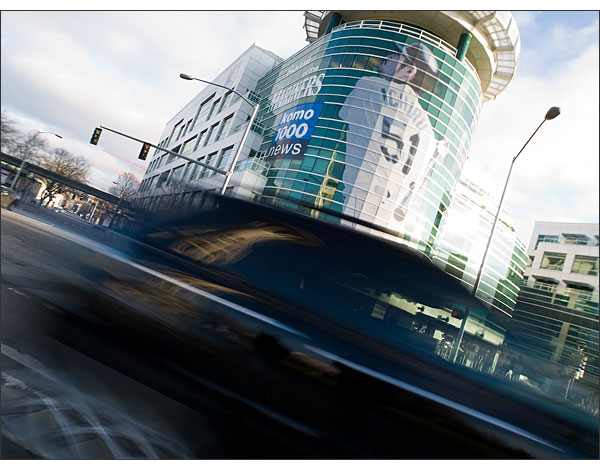
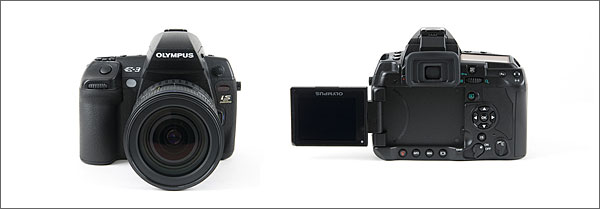

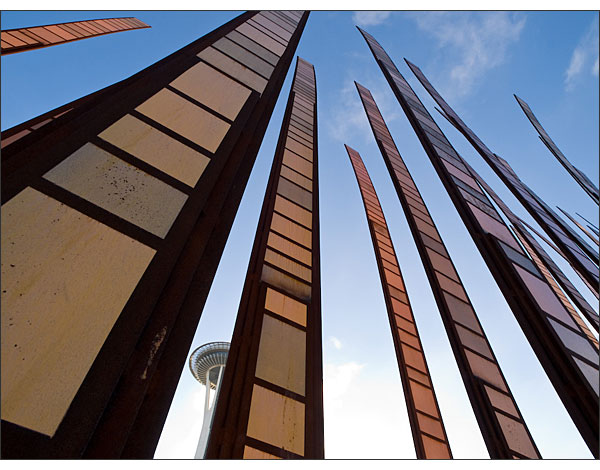
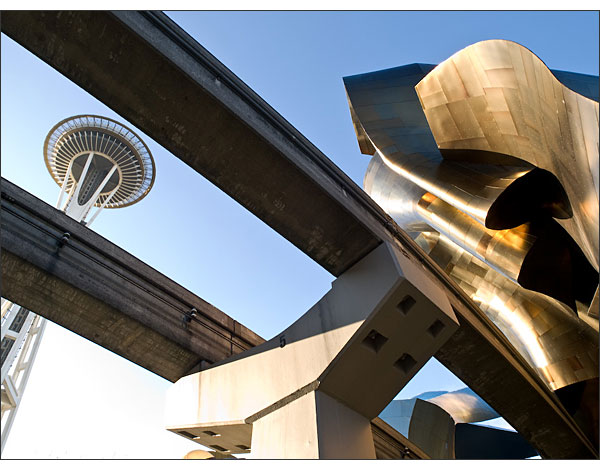
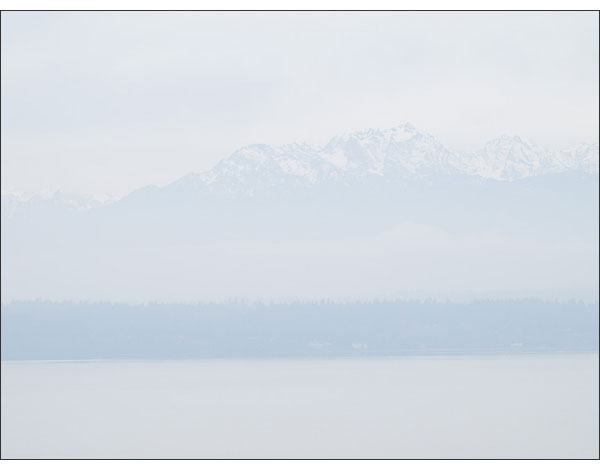
Good review, but.
Please keep in mind the 4/3 sq format as you describe is actually almost a perfect 8×10 or 16×20 aspect ratio.
This is a very popular aspect ratio that many C&N owners have to crop to.
So I think it is a pro not a con.
Essentially it makes the 10mp sensor act more like a 12 that has been cropped.
As far as your other cons I guess it depends what you are used to.
That’s a very good point about the 4:3 proportions. However, not everyone likes to shoot just to fill a particular paper size. Personally, I compose and crop to best compliment my subject. And I usually end up with proportions somewhere in-between 4:3 and 2:3. So the proportions of any camera will be a pro for some and a con for others. After all, there are some photographers who love the square format – God bless them
XD Cards have their advantages too, they are small, compact, lightweight, and yes FAST. Have you ever used a XD Card in the Fuji S3 Pro before? Much much faster than using a CF card.
I have been using the 2/3 format cameras for a few years now waiting on Olympus to produce a camera with this sort of spec. Though I mainly shoot macro and wildlife I also do the occasional wedding and event photography and find the 4/3 fromat great as sometimes being stuck for space somewhere or a grab shot i am left with no room to crop into standard paper sizes. If I do need a longer print I find with the 4/3 format it is much easier for me to loose a bit at the top and bottom of a print to obtain a longer aspect . It is much easier to work with clearly deined sides to sqeeze groups etc with out having to worry that the sides wont be lost when it comes to printing out standard sizes. Afterall most paper and frame sizes are easier to obtain in this aspect ratio.
As i said I do print out a few custom sizes for my own use but again its easier to loose the top or the bottom of a crop to give me a longer shape print .
I have worked all this out and the actuall total pixel loss is much greater croping 2/3 ratio images for srtandard paper sizes than the other way around.
All in all the new E3 is for me something Ive been looking for in the one package for some time now with much more natural looking images. The 12-60mm lens is great for weddigs due to the extra wide end and image stabilization.
Another point is the live view, I never thought much about this untill I got the camera just how usefull this funtion is. I often find myself trying to get into all sorts of weird position puotographing insects and things more often than not scarring off the subject trying to squint through the viewfinder. Ive used this funtion a few times now recently shooting over the heads of othe photographers and people to get the picture .
Great piece of kit -Thanks Olympus for restoring my faith in your products
Glenn:
Thanks for your comment. As I mentioned in my review of the Olympus E-510, the 4:3 aspect ratio doesn’t agree with my taste as it doesn’t fit the Golden Mean which is closer to 3:2. But truly, this is a matter of what you’re used to and I’m glad you find 4:3 to be more to your liking. Personally I’d rather crop my pixels off the sides to get 4:3. In past reviews, I have mentioned that one of my favorite cameras is the Panasonic LX-1 which is 16:9, so that tells you my bias.
Really with a camera as good as the E-3, the “cons” are indeed things that relate to what you’re used to… Someone accustomed to working with another camera system may find more cons than I did, such as “doesn’t shoot 8 frames per second,” so there is always some subjectivity. Nonetheless thanks for the feedback.
St. Francis, thanks for the comment on xD. I wish I had one included with the camera so I could directly compare, but that wasn’t the case for this review. Perhaps someone who has compared will post their experience with the format vs. CF.
Stephen, thanks for your thoughts on cropping. For me, it’s not about matching my sensor to a paper size since I know that some up/down-rezzing is always necessary. But again, to each their own and if 4:3 works best for your output, more power to ya!
Merry Christmas/Happy Holidays all,
LC
It’s a very good digital camera, like other DSLR brands/makes, for all kinds of photography. The enduser-photographer must optimize or maximize its features during the photo shooting to achieve most near to ideal image quality of the photo in mind with the actual. No camera system can produce actual image but only near quality image. Four-Thirds is the new technology for DSLR camera sensor that compliments the traditional camera sensor technology. There are pros and cons in either technology but a group of DSLR camera manufacturers is bringing new Four-Thirds sensor technology introducing new techniques meeting the ideal 35mm frame quality. E-3 has its own features to be the new choice for all kinds of enduser-photographers. It’s one of the new line of modern performance cameras.
Merrry X-mas to all!
I’ve had my E-3 (with 12-60) for about a week now, and I am blown away with the features, build quality, and image quality. Having never worked with IS before, I know it will take some effort and learning to make effective use of it. I find I can hand-hold decent one second shots… but unfortunately, the subject generally cannot hold still that long! So I have a bunch of sharp backgrounds and streaky-looking people. I think the most benefit from IS will come from longer lenses and faster shutter speeds, so now I’m lusting after the 50-200 SWD.
I am not a professional photographer, therefore I cannot comment from that viewpoint. I have used the consumer version E-Volt E-300 DSLR for a couple years now and find that the 4/3rds format suits my needs for website and print use to a “tee”. I do a lot of website work for two organizations as a volunteer and find the Olympus approach to DSLR photography to be one more suitable for consumer use and I expect that it would also suit many, if not all except for the most stringent of professional needs. I have had other brands of digital cameras, none of which even approached the confidence I have in the Olympus brand.
The thing about 3:2 and 4:3 is that 3:2 is typically used for small 4″x6″ prints, while 4:3 or more square formats are more typical of larger prints.
If you think about it, it’s better to “Crop to size” for a smaller final print version, than to crop off valuable resolution if you’re going 8×10 or larger.
Having said that composition of the subject matter can be difficult and annoying if you 99% of the time print 4×6′s like most people do.
nice review overall.
Although 4/3 is not the weakness of the system imo. Juzz adaptable for a while and still having the terrific image quality (very natural colour reproduction)
As a photographer I am simply an artist. I have worked in many different mediums, and I have a tendency to favor a canvas tailored to my needs. I own both the E3 and an Evolt 500. I have grown very accustomed to the 4/3rd aspect. I just like using it. I have used many 35mm and 2/3rd format systems. I grew up on a Diana plastic 620mm, then the Oly Pen F/T “Half-frame.” While in the Navy graduated to Graphic 4×5 and Leica 35mm Rangefinders, a multitude of many 35 and 120mm SLRs, finally into 1inch Videotape, and 16mm cine. I learn to enrich my experience in every camera format became confident in. I had one HECK of a time getting a warm and fuzzy in DIGITAL EQUIPMENT. I am almost there, especially with all the benefits in this film free medium. I have to say – I feel comfortable in many formats. I do however find the demand for perfection of composition a bit more challenging in 4/3rd aspect. this demand keeps me on my “Old” toes. Your review was excellent, your knowledge and experiece welcome! Thanks for this forum to share our thoughts – we learn from sharing with others.
1. thanks for the review.
2. one question / concern: as someone who bought the E-510 last year, i was dissapointed with the limited dynamic range–> thus i had to return the camera. i did all of my basic test shots in RAW and compared it to my Sony R1 and it was obvious to any objective person that the E-510 had limited dynamic range… which is a problem because all digital cameras suffer from this problem (compared to negative film).
3. thus, the big question is how is the dynamic range of the E-3, especially since the sensor is similar to the E-510? i know via olympus, the sensor is similar but different, but in reality, i’d really like to get an objective opinion on this important issue.
thanks for the unbiased info. harry shin
Thanks for the review!
I’ve got the E-3, 12-60 and 50-200swd now for a couple of months and i bought it as an expensive reliable travel kit. Build quality is indeed stunning, especially weather sealing.
Practicallity CF Writes a lot faster as XD though, i use both, but big difference.
The tilt and swivel lcd was a reason to buy the e-3, very practicall, wish that at least contrast detect AF worked on it though.
Lightroom is not able to translate some of the settings of the ORF RAW format, which makes them sometimes real raw again. (especially sharpening, higlight/shadow compensation etc… Which is a shame i like lightroom more than olies stuff. This template helped me a lot though. http://www.zs2.hu/csgzsfoto/technical/LRtemplates/
but its still not there completely.
I can also recommend getting a color calibration tool for your monitors, all of mine where a weeeee different.
But bottom line, i love it.
Thanks for your comments on the Olympus E-3, Ivo. We would appreciate it if you would post a review for your camera and lenses in our user reviews. You obviously know the camera well and your experience would be a welcome addition to our E-3 reviews:
Olympus E-3 User Reviews >>
Thanks again for your comments and thanks in advance for your reviews! Spread the word!
One frequently overlooked advantage of the 4:3 aspect ratio is the more natural appearance it gives to portraits which look more natural than a 3:2 ratio. When viewing photos on the new wider aspect computer screens such portraits are much easier to see. Unlike cameras which use a 3:2 ratio this camera gives you the option of shooting in both aspect ratios which increases its versatility considerably.
Thank you for your review(s). I learned a lot, and especially appreciate that the message is so positive. I recently added to my Lumix DMC-L1 by buying the E-3, w/14-35mmf2.0, which I am scheduled to receive in two days from now. Can’t wait! I am sure this is going to be a renaisannce in shooting for me. Your reveiws and comments corroborate my intuition and choices for buying the Olympus system over the D300, which was the only other contender for me. Again, thank you all for making me now even more hyper, and awake at 3AM, as I am now, reading about my new soon to arrive camera kit!
I am a serious amateur photographer, I love it as a hobby not having to work to someone else’s agenda.
I am curious that weather sealing was not mentioned in review, nor in any comments except for the ‘traveller’.
Weather sealing is invaluable if for no other reason than expensive electronic equipment and water are not compatible. I love having that security.The E3 is a survivor.
It’s a camera for every condition (except probably for getting too close to the sun)
Love it!!
I have been using the E-3 with 12-60 and 7-14 for the past week and am very pleased with the experience, so much so that I will be ordering my own next week.
I have printed up to 13X19 and the results are superb! The DOF provided by the 4/3 format, along with the exceptional OLY glass when combined with the excellent build quality and weather sealing makes this outfit a winner!
I am a professional photographer who in my advancing years appreciates the size difference vs the FF models.
Hi, I just wanted to comment on two things.
First, you listed the 4:3 aspect ratio as a con. I think thats a little misleading. Its your opinion that 3:2 is a better aspect ratio, for your needs, that doesn’t mean that its a con. The standard print sizes match the 4:3 aspect ratio more closely then the 3:2 aspect ratio does. You don’t mention this in the review, why? For people that print 5×7, 6×8, 8×10, 11×14, and 16×20 (those are the most common frame sizes and, I left out 4×6 because most people put that size in photo books) I see the 4:3 aspect ratio as a pro (my opinion, I know). I just don’t see how you can list the 4:3 aspect ratio as a con and not bring up the positives about the 4:3 aspect ratio. I think a lot of people that read your review will be ill-informed.
Second, I couldn’t agree with you more about the xD Picture memory cards as a second option. That’s not good for the customer. There are only two types of memory cards that should be used, CF and, SD. They are the most common type of Flash Memory on the market. Most P&S cameras use SD as the memory type and all dslr’s use CF or SD. I don’t see why manufacturer use other memory types. They need to let xD, MS and, MMC die off, that would be great for the customer, I think.
With all that said, I think you did a great job with this review, I in-joyed reading through it and now I want to upgrade my e-510 to an e-3. Thanks for the review and thanks for reading my rant. I think I made some good points about the 4:3 aspect ratio and hope that you will consider them and maybe add them in a review some time (not as a pro or con but, as some info as to who would benefit from the 4:3 aspect ratio)
Personally, I love this camera… and I think this review is quite fair–and detailed… sweet pic’s too… I especially like angles/architecture shots (how about some captions that tell about the pic’s?)…
For an updated perspective on this cam, Jack Neubart (of Shutterbug fame) just published a
review of the Olympus E-3 camera over at Photocrati…
Cheers